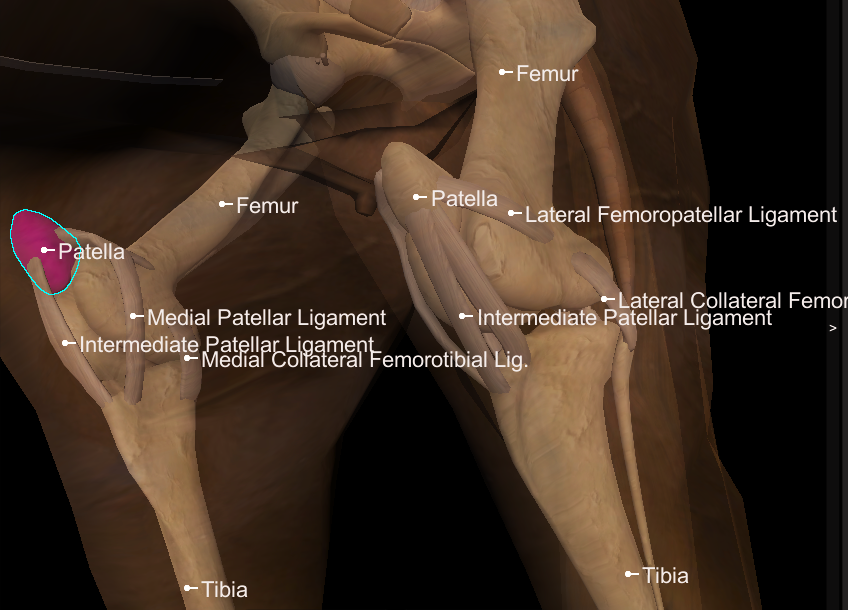The Stifle joint in horses, often likened to the human knee, is a remarkable and intricate mechanism essential for both movement and support. The Stifle plays a pivotal role in a horse’s locomotion, allowing it to execute a wide range of movements. Beyond its role in movement, the stifle also contributes to a horse’s stability when standing, forming an integral part of what is known as the “Stay Apparatus.”
Anatomy of the Stifle Joint
The Stifle joint in horses is a marvel of complexity, composed of several interconnected elements that enable its diverse functions:
Three Bones: The Stifle joint consists of three bones: the lower end of the femur (thigh bone), the patella (knee cap), and the upper end of the tibia (shin).
Two Large Joints: Within the stifle joint, two significant joints exist – the Femoropatellar joint, situated between the femur and the patella, and the Femorotibial joint, which is divided into medial (inside) and lateral (outside) compartments.
Ligaments: Several ligaments provide stability to the Stifle joint. These include two Collateral ligaments located on either side of the Stifle joint between the Femur and the Tibia, three patellar ligaments that attach the lower part of the patella to the tibia, and small cruciate ligaments inside the joint that prevent abnormal movement.
Fibrocartilage Discs (Menisci): Two crescent-shaped discs of fibrocartilage called the Menisci are positioned between the Femur and Tibia. These Menisci serve to absorb shock, reduce concussion, provide cushioning, and ensure consistent contact between the two bone ends.
Joint Capsule and Synovial Fluid: A joint capsule surrounds the Stifle joint, containing synovial fluid that lubricates and facilitates smooth movement of the bones during flexion and extension. It also supplies nutrients to the joint’s cartilage.
The Stifle joint’s significance extends beyond movement; it plays a vital role in supporting a horse during rest and standing. This collective system, known as the “Stay Apparatus,” engages to enable a horse to remain upright with minimal muscular effort, even during extended periods of rest. The Stay Apparatus serves to prevent the leg from collapsing, achieving this through a three-phase mechanism:
- Stifle Lock: Horses can lock their Stifles due to the unique anatomy of the Patella and its ligaments, combined with the Femur’s Trochlear Ridge. When a horse rests, the medial ligament of the patella hooks onto the medial trochlear ridge on the femur, effectively locking the stifle joint in place.
- Reciprocal Mechanism: The Reciprocal Mechanism links the Stifle and the Hock with Peroneus Tertius tendon Superficial Digital Flexor tendon.
- Suspensory Apparatus: As the Stifle and Hock joints lock into position, tendons and ligaments in the lower limb secure the lower leg, maintaining stability and preventing overextension of the Fetlock, Pastern, and Coffin joints.
Stifle problems in horses can arise from various causes, including anatomical issues, overuse, injury, or degenerative conditions. Here are some common factors that can lead to stifle problems in horses:
- Trauma: Direct trauma to the stifle area, such as a kick or a fall, can cause injury to the joint, ligaments, or tendons, leading to stifle problems.
- Overexertion: Overexertion or excessive strain on the stifle joint, often due to intense exercise or improper conditioning, can result in strain or injury.
- Congenital Anomalies: Some horses may be born with congenital abnormalities of the stifle joint, such as angular limb deformities, that can predispose them to stifle issues.
- Osteochondrosis (OC): OC is a developmental orthopedic condition that can affect the stifle joint. It involves the abnormal development of cartilage and can lead to loose fragments within the joint, causing pain and lameness.
- Arthritis: Arthritis can develop in the stifle joint over time, causing inflammation, pain, and reduced mobility. It may be associated with wear and tear, injury, or certain diseases.
- Infections: Infections in the stifle joint can lead to conditions like septic arthritis, which can cause severe lameness and joint damage if not treated promptly.
- Ligament and Tendon Injuries: Damage to the ligaments and tendons surrounding the stifle joint can lead to instability and lameness.
- Muscular Imbalances: Weak or imbalanced muscles around the stifle joint can affect joint stability and function, potentially leading to problems.
- Age and Wear: Older horses are more prone to stifle problems due to natural joint degeneration and accumulated wear and tear over the years.
- Excessive Weight: Obesity or excessive body weight can place added stress on the stifle joint, potentially contributing to problems.
- Improper Shoeing: Poorly fitted or unbalanced horseshoes can affect a horse’s gait and place strain on the stifle joint.
- Genetics: Some horses may be genetically predisposed to certain stifle conditions or anatomical abnormalities.
It’s important to note that the specific cause of Stifle problems can vary among individual horses. Monitoring a horse’s Stifle is essential for maintaining its health, preventing issues, and addressing any existing problems promptly. Detecting issues early often leads to better treatment outcomes and can prevent the progression of diseases. If a horse displays signs of Stifle problems, such as lameness, swelling, heat, or discomfort in the Stifle area, it is essential to consult a veterinarian for a proper evaluation and treatment plan.





